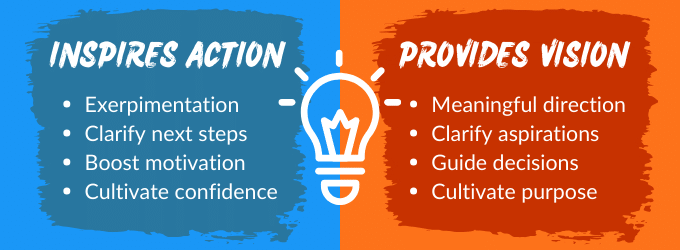Short-term vs Long-Term Goals: Why You Need Both to Succeed

- What is a long-term goal?
- What is a short-term goal?
- Similarities between long-term and short-term goals
- Differences between short-term and long-term goals
- How to set effective long- and short-term goals?
What is a long-term goal?
Long-term goals reflect the most meaningful objectives in your life, taking longer than a year to achieve. It’s your grand vision that includes life goals, your personal vision, and professional goals.
They provide direction and a sense of purpose, guiding your decisions and actions. Aspirational goals also help you channel your short-term objectives into a focused direction, driving continuous success and fulfillment.
Some examples of long-term goals include:
- Career: Become a senior manager within 5 years.
- Business: Sell a million products within 20 years.
- Fitness: Run a marathon in the next 18 months.
- Finance: Have $20,000 in your emergency fund within 3 years.
- Relationship: Visit 50+ countries with your partner before 2050.
- Personal growth:Speak a new language fluently in 3 years.
Do you feel lost?
Take this free personality test to uncover your personal blueprint for success and happiness. Within minutes, you gain insights into your personality and strengths, allowing you to set better goals, experience more joy, and feel fulfilled.

What is a short-term goal?
Short-term goals are specific and achievable objectives, ranging from a few days to several months – but less than a year. Common types include weekly goals, monthly goals, and quarterly goals.
Immediate goals can serve different purposes:
- Breaking down aspirational goals into manageable steps.
- Experimenting with new ideas, strategies, hobbies, sports, etc.
- Or you can use them as standalone goals and projects.
The power of short-term objectives is that they provide a clear roadmap for immediate action. And they provide frequent rewards and feedback, fueling motivation and self-confidence.
Some examples of short-term goals include:
- Career: Create your roadmap to a senior position this month.
- Business: Create your website this quarter.
- Fitness: Try yoga three times a week for 20 weeks.
- Finance: Save $5,000 within six months.
- Relationship: Date once a week for 3 months.
- Personal growth: Meditate 60 minutes daily for a week.
Before we dive into the differences, let’s first understand the…
Similarities between long-term and short-term goals
All types of goals do – or should – share the following similarities:
- They provide clarity: Distant and immediate goals both clarify your intention and provide a target to aim at.
- They increase personal fulfillment: Pursuing any goal channels your energy in a positive direction, increasing satisfaction.
- They can relate to each other: Many short-term objectives are stepping stones to greater personal goals.
- They should be SMART goals: Good goals are Specific, Measurable, Achievable, Relevant, and Timely. While this concept applies to both goals, there are some nuances within the SMART formula between short-term vs long-term goals, which brings us to the…
Differences between short-term and long-term goals
Long-term goals provide a big-picture overview, take 1+ year to achieve, and are aspirational in nature. Achieving short-term goals takes a week to several months and provides clear stepping stones for action.
The key differences between the two are:
- Purpose
- Timeframe
- Specificity
- Goal orientation
- Trackability
Let’s dissect this:
#1: Purpose

- Short-term goals are great for experimentation, clarifying your next steps, creating effective stepping stones to achieve your dreams, and increasing motivation and self-confidence.
- Long-term goals provide a clear future vision, clarify your direction, guide your actions and decisions, and provide a sense of meaning and purpose.
#2: Timeframe
- Short-term goals are typically defined as goals that you can achieve within a week, a month, or a year.
- Long-term goals take much longer to achieve, with a minimum of 1 year and no maximum. Although uncommon, these goals can extend beyond a single lifetime.
It’s worth noting that there’s no set definition for short-term vs long-term goals. It differs per individual or organization.
For example, you may prefer these four types of goals:
- Micro goals: 1 day to 1 week
- Short-term goals: 1 week to 12 months.
- Mid-term goals: 1 to 3 years.
- Long-term goals: 3+ years.
But let’s continue with our current and most common definition of short-term goals (

#3: Specificity
- Short-term goals should be the most precise and achievable. In other words, you want realistic goals that drive action – not induce fear and procrastination.
- Long-term goals are aspirational and can be more generic. Although the outcome of your goal should be clear, they may feel daunting. And you may wonder if and how you’ll ever achieve them – and that’s okay.
The general rule is that the shorter the period to achieve your goal, the more realistic and achievable it should be.

#4: Goal orientation
- Short-term goals should most often be action-oriented to increase motivation and reduce procrastination. For example, making 30 sales calls today is better than making 3 sales today.
- Long-term goals are often outcome-oriented, like making 500 sales this year or becoming a millionaire before 2030.
The shorter the period, the more important it becomes to set process goals – that are 100% within your control – instead of outcome-oriented ones.
While there’s a place for short-term outcome goals (making 3 sales), ensure you set action-oriented ones too (making 30 sales calls). The opposite is less important, although long-term process goals can help you track progress.

#5: Trackability
- Short-term goals are typically easier to track because they’re more specific and often action-oriented. Consider these short-term goal examples: run 50 miles this month and run 3 times this week.
- Long-term goals are often harder to track because they’re more aspirational. One long-term goal example is to run an ultra-marathon within 5 years. That said, you can set the adjacent goal to run 1,500 times within 5 years, which enables you to measure progress and encourage continuous action.
Now you know all about the similarities and differences between short-term and long-term goals, one question remains.

How to set long- and short-term goals?
There are several ways to set powerful goals.
But I’ve found the best way is to identify all your desires and aspirations. And then, turn these into life goals with this step-by-step guide to set goals.
Part of that guide is breaking up your long-term goals.
For example, break up 10- and 5-year goals into yearly goals. And I break my yearly goals up into quarters. I then take the first quarter and make a rough draft for what I want to achieve for each of the next 3 months.
But it doesn’t stop there.
Every week, I set weekly goals and daily goals. And every day, I check in with these goals to stay on track. These daily goals consist of process goals and tasks that form a clear plan of action.
Do you want a more in-depth example?
In this goal-setting guide, I provide an easy step-by-step approach to set goals, including a personal example to illustrate the process.
If you want a general idea, here’s a…
Personal goal example
Below are some long-term goals examples of my own, including smaller goals that I want to accomplish:
- Mission: Help people live more fulfilling lives.
- 5-Year mission goal: Inspire 1+ million people every year to live a happier and more fulfilling life.
- 5-Year adventure goal: Travel to 50+ countries and live in one place in each continent for at least 3 months.
- 1-Year mission goal: Reach 100K+ people this year.
- 1-Year fitness goal: Do 3 clean handstand pushups.
- 1-Yearcareer goal: Cover my expenses with 20 hours of freelancing per week, focusing the rest of my time on my mission.
- Quarterly relationship goal: Connect with all my important friends or if they live nearby, meet with them in person.
- Quarterly mission goal: Upload 12 blog posts.
- This month’s health goal: Visit a wellness center or spa.
- This month’s mission goal: Write 4 blog posts.
- This week’s mission goal: Create 4 blog outlines.
- Today’s mission goal: Identify the 12 blog topics for this quarter.
Do you notice how my mission goal trickles down from long-term to more immediate goals? And how other goals are standalone objectives?
Also, I lack immediate adventure goals to achieve my 5-year goal because I plan to go on a longer road trip within a couple of years.
While this is only a snapshot of my goals, hopefully you get the point.
What’s next?
Combining short-term with long-term goals serves as a compass that guides your decisions and actions, propelling you toward your dreams.
By harnessing the direction of a greater vision and the motivation of small wins, you’ll unlock more personal growth and inner fulfillment.
Key takeaways:
- Align your short-term goals with long-term aspirations for more success and personal fulfillment.
- Short-term goals offer focus, motivation, and confidence.
- Long-term goals provide meaning, purpose, and direction.
Further resources:
- Check out the best books about goal-setting
- Course:Goal-Setting Mastery: 10X Your Results in 12 Months
- Tool:Goals on Track is the tool I use for all my goals. Learn more about this app in my extensive review of Goals on Track.
Take action: Identify one long-term goal that aligns with your passion and purpose. Break it down into smaller, actionable steps.
Do you want to achieve your goals and dreams? Sign up below to receive weekly actionable insights to live a more meaningful and fulfilling life!








